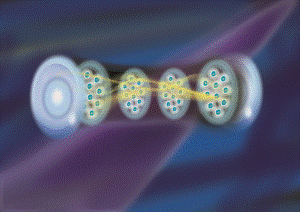Jul 17 2014
With atoms and light, CQT researchers have built a 'simulator' of atom-light interactions. As circular as it sounds, the approach creates a promising new playground for testing theoretical ideas.
 The 'Dicke model' of atom-light interactions has effectively guided quantum experiments, but it has some puzzling features. A team including CQT researchers is using 'pancakes' of ultracold atoms trapped between two mirrors, as shown here in an artist's illustration, to investigate the model's behaviour.
The 'Dicke model' of atom-light interactions has effectively guided quantum experiments, but it has some puzzling features. A team including CQT researchers is using 'pancakes' of ultracold atoms trapped between two mirrors, as shown here in an artist's illustration, to investigate the model's behaviour.
"After we put the paper on arXiv, people immediately wrote to us asking 'can you do this'?", says Markus Baden, a CQT PhD student and first author on the paper. "We're excited about the possibilities," he says.
The paper describing a setup that realises the 'Dicke model' is published 10 July in Physical Review Letters.
The Dicke model of atom-light interaction is widely used in quantum physics. In its full form, it describes how atoms with two energy levels interact with light of one frequency. The model's various approximations – eg, for weak interactions and single atoms – often match the setups that experimentalists explore in their labs.
Effective as the Dicke model has been in guiding quantum experiments, it also has some puzzling features. It was noticed in the 1970s that the model predicts a 'superradiant' state for atoms that interact strongly with light. This sparked debate over whether the phase transition to superradiance is an artefact of an over-simplified model or a real, physical phenomenon. In general, atoms do not interact strongly enough with light to reach the regime where the transition is predicted to happen.
Seeing superradiance
In the CQT setup, the simple situation described by the Dicke model is simulated using a more complex set of atom-light interactions. The beauty of this approach is that it makes the interaction strengths tunable. Markus and his collaborations could make the interactions strong enough to trigger the phase transition: they measured the onset of supperradiance in their system.
One goal of simulating phase transitions is to be able to study the mechanics and timescale of the change in detail. Models typically predict the 'before' and 'after' states without giving much insight into how one turns into the other. Current models give some coarse ideas about dynamics, but there are more open questions than answers. The researchers can change parameters in the simulated system to explore the dynamics in detail.
Superradiance was also seen in 2013 in experiments in Zurich that realised the Dicke model using a different approach. What excites Markus and his CQT co-authors Kyle Arnold, a Research Fellow, and Murray Barrett, the group's Principle Investigator, about their approach is its flexibility. "We know exactly which dials to turn to look at different corners of the Dicke model," says Kyle.
The CQT experiment follows a proposal from a group in New Zealand, including the paper's co-author Scott Parkins at the University of Auckland, to realise the Dicke model using cavity-assisted Raman transitions. This means trapping atoms inside a mirrored cavity to enhance their interaction with light, such that the atoms make a transition from one energy level to another by absorbing energy from an incoming laser and emitting it into the cavity light field, or vice versa. The team implemented transitions between two 'hyperfine' energy levels of Rubidium-87. PhD student Arne Grimsmo from The Norwegian University of Science and Technology in Trondheim worked with Scott to adapt the proposal to the setup at CQT.
To perform the experiment, the CQT researchers trapped some hundred thousands atoms between two mirrors about 10mm apart. First the atoms are cooled until they form a cloud in a magneto optical trap, 15mm above the cavity, then a strong light field is used to move the cloud between the mirrors. Once in the cavity, the atoms collect in a row of 'pancakes' (see artist's impression). Two laser beams shone through the pancakes control the atoms' transitions between energy levels, and the interaction strength is tuned by adjusting the incoming lasers' frequency and power. With all this is in place, each data point takes only a few milliseconds to collect.
The group are now deciding what experiments to perform next, based on what may be learned from them and how quickly they can be implemented. After doing a more detailed investigation of the Dicke model, the researchers might extend the setup, for example by adding more lasers to simulate atomic systems with more than two energy levels. For these more complex cases not described by the Dicke model, people don't always know what's going to happen.
Source: http://www.quantumlah.org/